1997 SSANGYONG KORANDO section 2c
[x] Cancel search: section 2cPage 1642 of 2053

SSANGYONG MY2002
8B-60 SUPPLEMENTAL RESTRAINTS SYSTEM
KAA8B140
DRIVER AIRBAG MODULE
Removal and installation Procedure
1. Disconnect the negative battery cable.
Caution: The SDM can maintain sufficient
voltage to deploy the airbags for 0.15 seconds
after the Ignition is OFF and the airbag fuse has
been removed. If the airbags are not
disconnected, service cannot begin until one
minute has passed after disconnecting power
to the SDM. If the airbags are disconnected,
service can begin immediately without waiting
for one-minute time period to expire. Failure to
temporarily disable the SRS during service
result in unexpected deployment, personal
injury, and otherwise unneeded SRS repair.
2. Disable the supplemental restraint system (SRS).
Refer to “Disabling the SRS” in this section.
3. Position the steering wheel straight ahead.
4. Remove the driver airbag module mounting bolts.
Installation Notice
Caution: When handling an airbag module,
always keeps the top of the unit facing upward.
This leaves room for the airbag to expand if the
module unexpectedly deploys. Without room
for expansion, a module suddenly propelled
toward a person or object can cause injury or
vehicle damage.
5. Remove the connector from the horn terminal and
the driver airbag module.
6. Remove the driver airbag module.
7. Installation should follow the removal procedure
in the reverse order.
Tightening Torque 8 Nm (71 lb-in)
Page 1643 of 2053
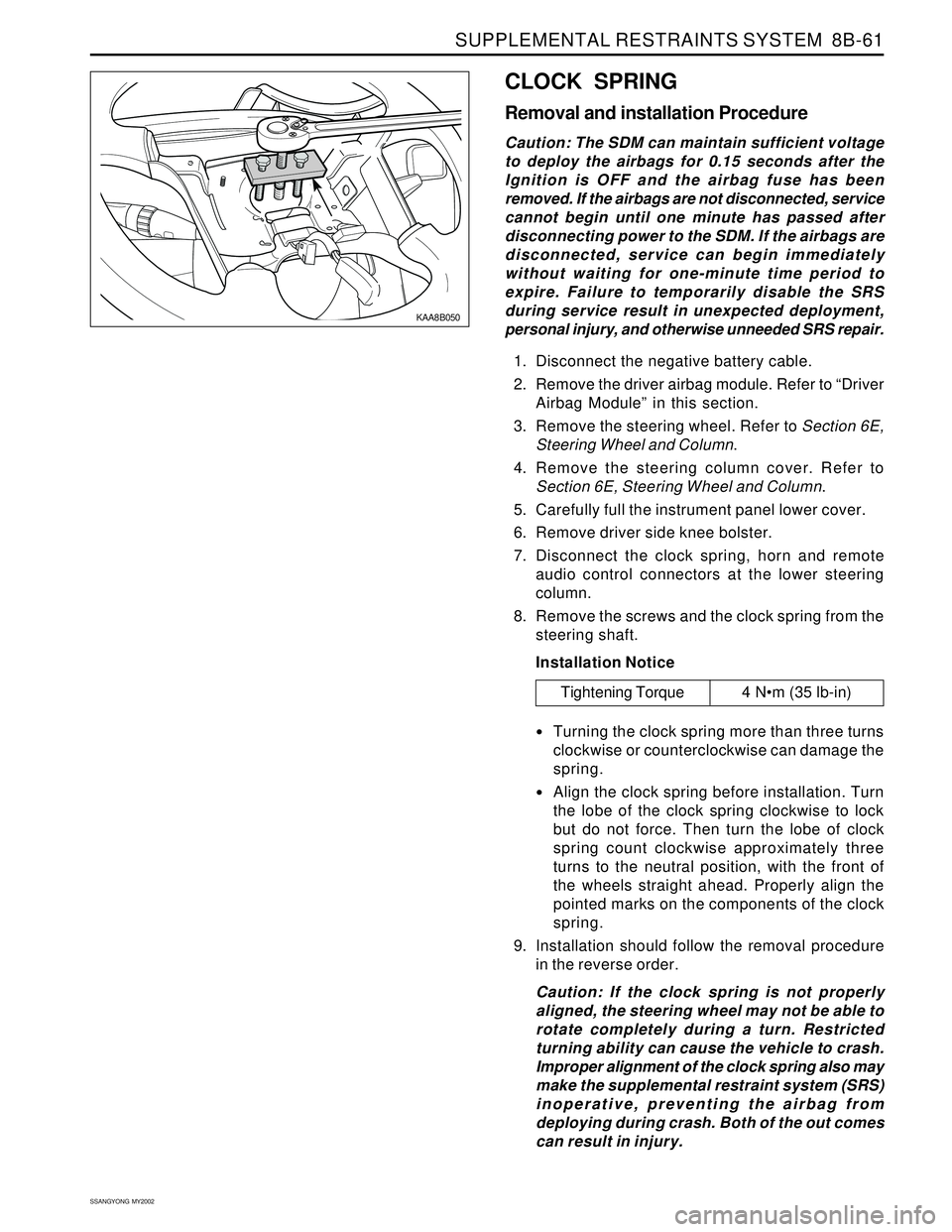
SUPPLEMENTAL RESTRAINTS SYSTEM 8B-61
SSANGYONG MY2002
KAA8B050
CLOCK SPRING
Removal and installation Procedure
Caution: The SDM can maintain sufficient voltage
to deploy the airbags for 0.15 seconds after the
Ignition is OFF and the airbag fuse has been
removed. If the airbags are not disconnected, service
cannot begin until one minute has passed after
disconnecting power to the SDM. If the airbags are
disconnected, service can begin immediately
without waiting for one-minute time period to
expire. Failure to temporarily disable the SRS
during service result in unexpected deployment,
personal injury, and otherwise unneeded SRS repair.
1. Disconnect the negative battery cable.
2. Remove the driver airbag module. Refer to “Driver
Airbag Module” in this section.
3. Remove the steering wheel. Refer to Section 6E,
Steering Wheel and Column.
4. Remove the steering column cover. Refer to
Section 6E, Steering Wheel and Column.
5. Carefully full the instrument panel lower cover.
6. Remove driver side knee bolster.
7. Disconnect the clock spring, horn and remote
audio control connectors at the lower steering
column.
8. Remove the screws and the clock spring from the
steering shaft.
Installation Notice
Turning the clock spring more than three turns
clockwise or counterclockwise can damage the
spring.
Align the clock spring before installation. Turn
the lobe of the clock spring clockwise to lock
but do not force. Then turn the lobe of clock
spring count clockwise approximately three
turns to the neutral position, with the front of
the wheels straight ahead. Properly align the
pointed marks on the components of the clock
spring.
9. Installation should follow the removal procedure
in the reverse order.
Caution: If the clock spring is not properly
aligned, the steering wheel may not be able to
rotate completely during a turn. Restricted
turning ability can cause the vehicle to crash.
Improper alignment of the clock spring also may
make the supplemental restraint system (SRS)
inoperative, preventing the airbag from
deploying during crash. Both of the out comes
can result in injury.
Tightening Torque 4 Nm (35 lb-in)
Page 1644 of 2053
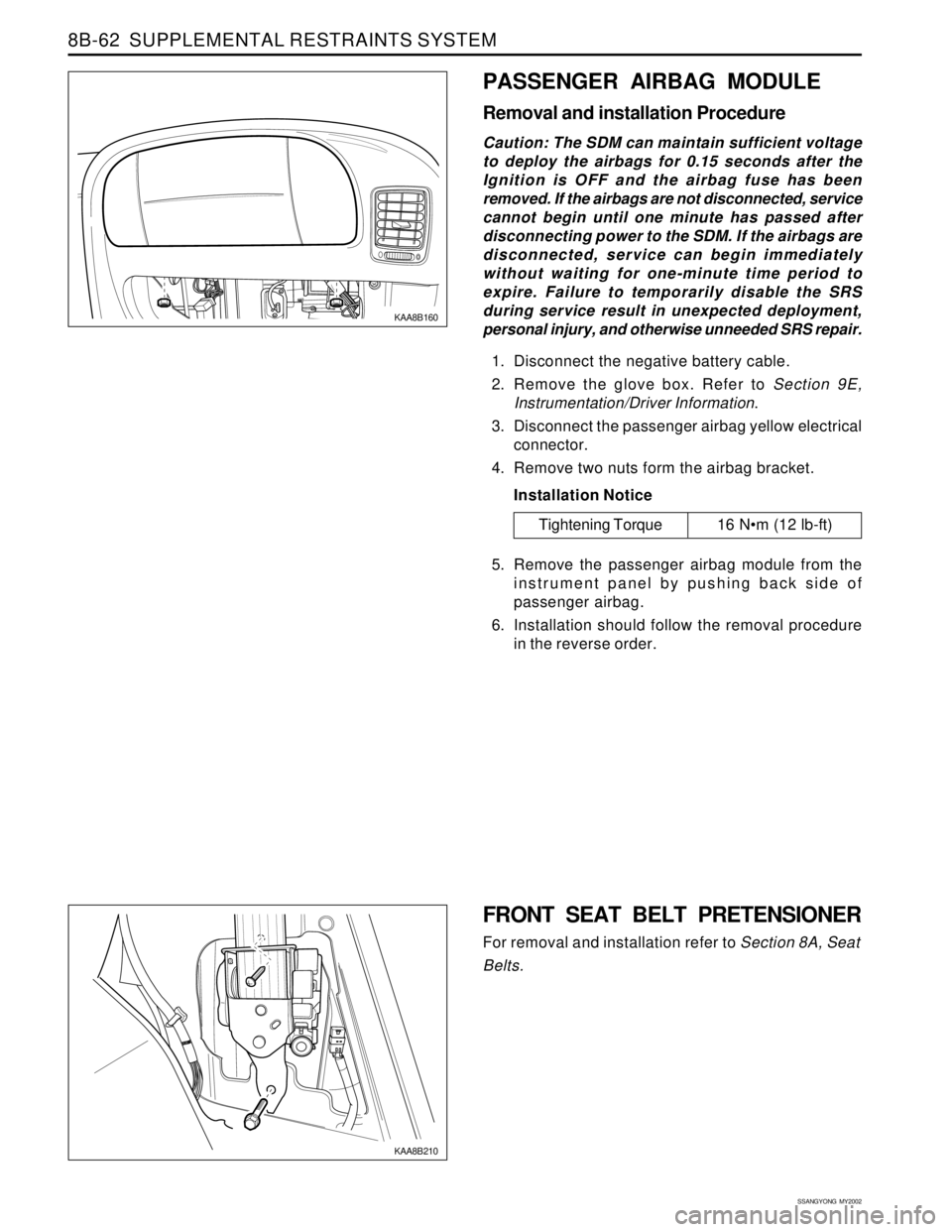
SSANGYONG MY2002
8B-62 SUPPLEMENTAL RESTRAINTS SYSTEM
KAA8B160
PASSENGER AIRBAG MODULE
Removal and installation Procedure
Caution: The SDM can maintain sufficient voltage
to deploy the airbags for 0.15 seconds after the
Ignition is OFF and the airbag fuse has been
removed. If the airbags are not disconnected, service
cannot begin until one minute has passed after
disconnecting power to the SDM. If the airbags are
disconnected, service can begin immediately
without waiting for one-minute time period to
expire. Failure to temporarily disable the SRS
during service result in unexpected deployment,
personal injury, and otherwise unneeded SRS repair.
1. Disconnect the negative battery cable.
2. Remove the glove box. Refer to Section 9E,
Instrumentation/Driver Information.
3. Disconnect the passenger airbag yellow electrical
connector.
4. Remove two nuts form the airbag bracket.
Installation Notice
5. Remove the passenger airbag module from the
instrument panel by pushing back side of
passenger airbag.
6. Installation should follow the removal procedure
in the reverse order.
Tightening Torque 16 Nm (12 lb-ft)
FRONT SEAT BELT PRETENSIONER
For removal and installation refer to Section 8A, Seat
Belts.
KAA8B210
Page 1645 of 2053
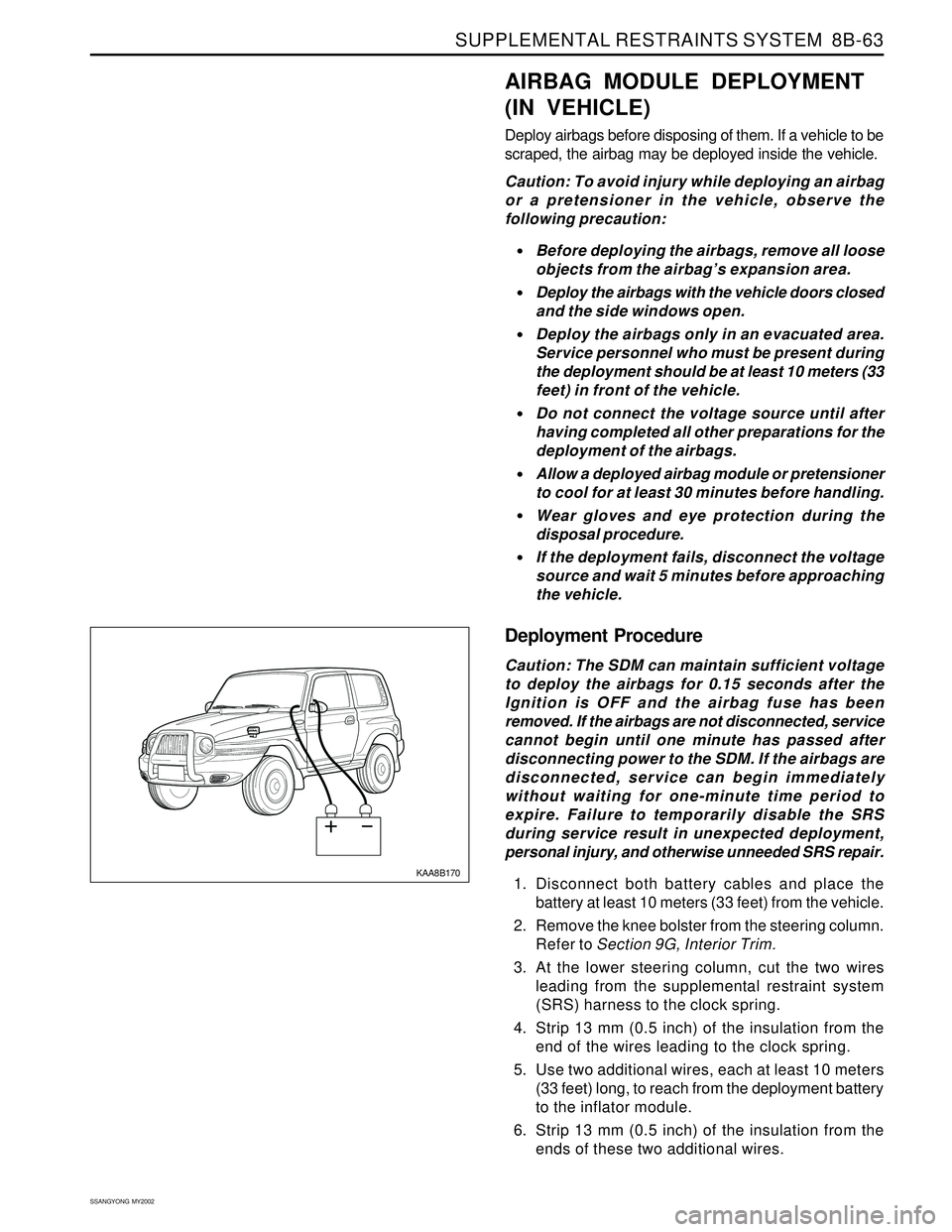
SUPPLEMENTAL RESTRAINTS SYSTEM 8B-63
SSANGYONG MY2002
KAA8B170
AIRBAG MODULE DEPLOYMENT
(IN VEHICLE)
Deploy airbags before disposing of them. If a vehicle to be
scraped, the airbag may be deployed inside the vehicle.
Caution: To avoid injury while deploying an airbag
or a pretensioner in the vehicle, observe the
following precaution:
Before deploying the airbags, remove all loose
objects from the airbag’s expansion area.
Deploy the airbags with the vehicle doors closed
and the side windows open.
Deploy the airbags only in an evacuated area.
Service personnel who must be present during
the deployment should be at least 10 meters (33
feet) in front of the vehicle.
Do not connect the voltage source until after
having completed all other preparations for the
deployment of the airbags.
Allow a deployed airbag module or pretensioner
to cool for at least 30 minutes before handling.
Wear gloves and eye protection during the
disposal procedure.
If the deployment fails, disconnect the voltage
source and wait 5 minutes before approaching
the vehicle.
Deployment Procedure
Caution: The SDM can maintain sufficient voltage
to deploy the airbags for 0.15 seconds after the
Ignition is OFF and the airbag fuse has been
removed. If the airbags are not disconnected, service
cannot begin until one minute has passed after
disconnecting power to the SDM. If the airbags are
disconnected, service can begin immediately
without waiting for one-minute time period to
expire. Failure to temporarily disable the SRS
during service result in unexpected deployment,
personal injury, and otherwise unneeded SRS repair.
1. Disconnect both battery cables and place the
battery at least 10 meters (33 feet) from the vehicle.
2. Remove the knee bolster from the steering column.
Refer to Section 9G, Interior Trim.
3. At the lower steering column, cut the two wires
leading from the supplemental restraint system
(SRS) harness to the clock spring.
4. Strip 13 mm (0.5 inch) of the insulation from the
end of the wires leading to the clock spring.
5. Use two additional wires, each at least 10 meters
(33 feet) long, to reach from the deployment battery
to the inflator module.
6. Strip 13 mm (0.5 inch) of the insulation from the
ends of these two additional wires.
Page 1646 of 2053
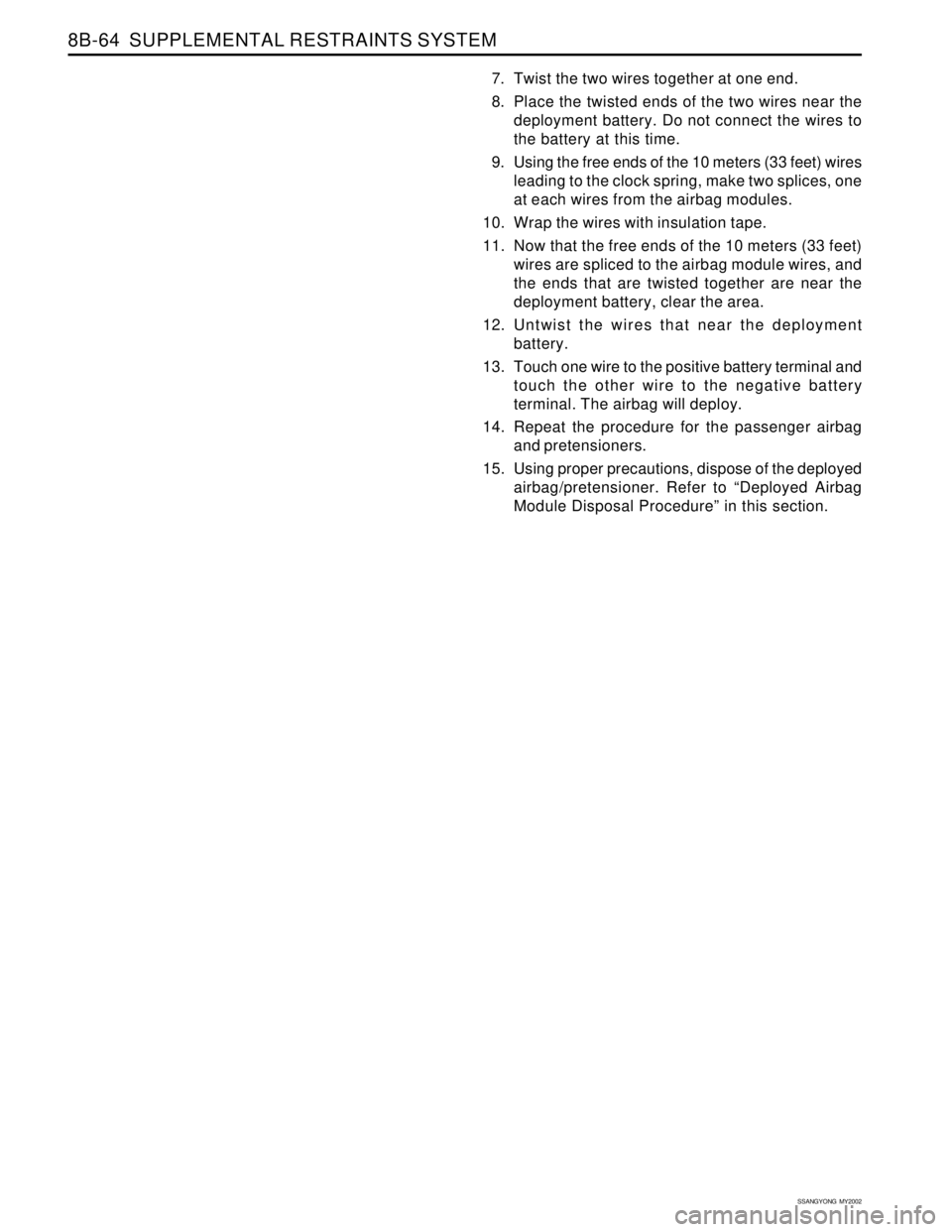
SSANGYONG MY2002
8B-64 SUPPLEMENTAL RESTRAINTS SYSTEM
7. Twist the two wires together at one end.
8. Place the twisted ends of the two wires near the
deployment battery. Do not connect the wires to
the battery at this time.
9. Using the free ends of the 10 meters (33 feet) wires
leading to the clock spring, make two splices, one
at each wires from the airbag modules.
10. Wrap the wires with insulation tape.
11. Now that the free ends of the 10 meters (33 feet)
wires are spliced to the airbag module wires, and
the ends that are twisted together are near the
deployment battery, clear the area.
12. Untwist the wires that near the deployment
battery.
13. Touch one wire to the positive battery terminal and
touch the other wire to the negative battery
terminal. The airbag will deploy.
14. Repeat the procedure for the passenger airbag
and pretensioners.
15. Using proper precautions, dispose of the deployed
airbag/pretensioner. Refer to “Deployed Airbag
Module Disposal Procedure” in this section.
Page 1647 of 2053
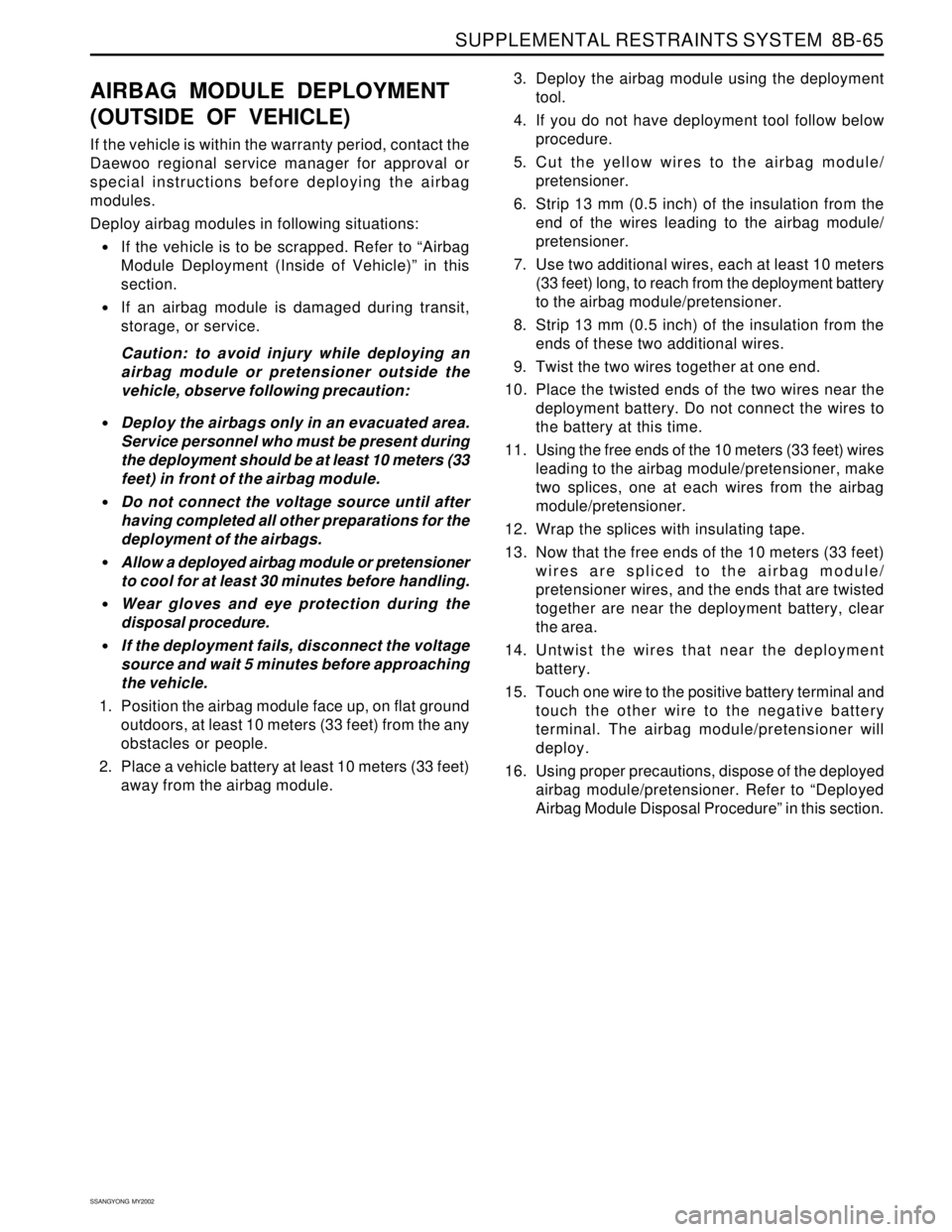
SUPPLEMENTAL RESTRAINTS SYSTEM 8B-65
SSANGYONG MY2002
AIRBAG MODULE DEPLOYMENT
(OUTSIDE OF VEHICLE)
If the vehicle is within the warranty period, contact the
Daewoo regional service manager for approval or
special instructions before deploying the airbag
modules.
Deploy airbag modules in following situations:
If the vehicle is to be scrapped. Refer to “Airbag
Module Deployment (Inside of Vehicle)” in this
section.
If an airbag module is damaged during transit,
storage, or service.
Caution: to avoid injury while deploying an
airbag module or pretensioner outside the
vehicle, observe following precaution:
Deploy the airbags only in an evacuated area.
Service personnel who must be present during
the deployment should be at least 10 meters (33
feet) in front of the airbag module.
Do not connect the voltage source until after
having completed all other preparations for the
deployment of the airbags.
Allow a deployed airbag module or pretensioner
to cool for at least 30 minutes before handling.
Wear gloves and eye protection during the
disposal procedure.
If the deployment fails, disconnect the voltage
source and wait 5 minutes before approaching
the vehicle.
1. Position the airbag module face up, on flat ground
outdoors, at least 10 meters (33 feet) from the any
obstacles or people.
2. Place a vehicle battery at least 10 meters (33 feet)
away from the airbag module.3. Deploy the airbag module using the deployment
tool.
4. If you do not have deployment tool follow below
procedure.
5. Cut the yellow wires to the airbag module/
pretensioner.
6. Strip 13 mm (0.5 inch) of the insulation from the
end of the wires leading to the airbag module/
pretensioner.
7. Use two additional wires, each at least 10 meters
(33 feet) long, to reach from the deployment battery
to the airbag module/pretensioner.
8. Strip 13 mm (0.5 inch) of the insulation from the
ends of these two additional wires.
9. Twist the two wires together at one end.
10. Place the twisted ends of the two wires near the
deployment battery. Do not connect the wires to
the battery at this time.
11. Using the free ends of the 10 meters (33 feet) wires
leading to the airbag module/pretensioner, make
two splices, one at each wires from the airbag
module/pretensioner.
12. Wrap the splices with insulating tape.
13. Now that the free ends of the 10 meters (33 feet)
wires are spliced to the airbag module/
pretensioner wires, and the ends that are twisted
together are near the deployment battery, clear
the area.
14. Untwist the wires that near the deployment
battery.
15. Touch one wire to the positive battery terminal and
touch the other wire to the negative battery
terminal. The airbag module/pretensioner will
deploy.
16. Using proper precautions, dispose of the deployed
airbag module/pretensioner. Refer to “Deployed
Airbag Module Disposal Procedure” in this section.
Page 1648 of 2053
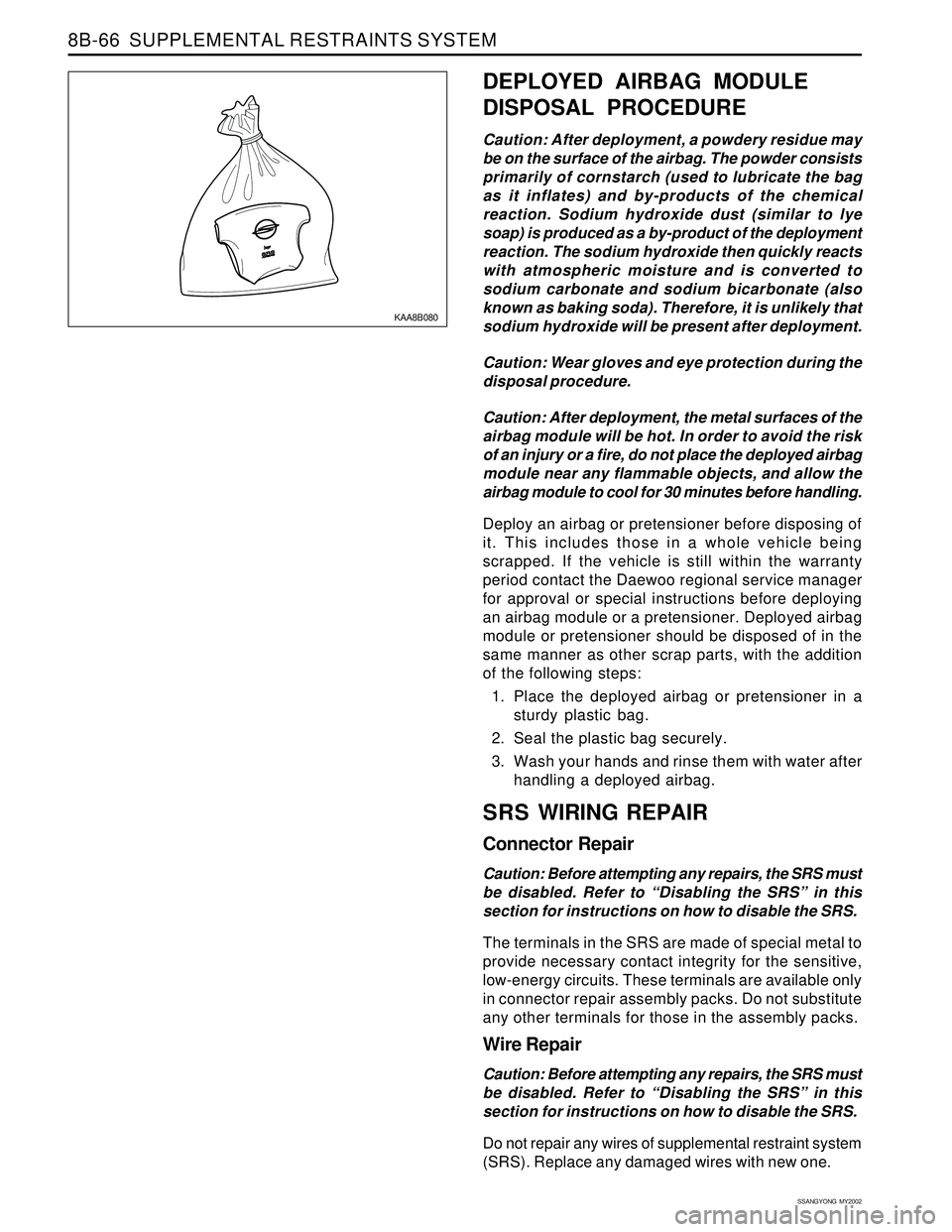
SSANGYONG MY2002
8B-66 SUPPLEMENTAL RESTRAINTS SYSTEM
KAA8B080
DEPLOYED AIRBAG MODULE
DISPOSAL PROCEDURE
Caution: After deployment, a powdery residue may
be on the surface of the airbag. The powder consists
primarily of cornstarch (used to lubricate the bag
as it inflates) and by-products of the chemical
reaction. Sodium hydroxide dust (similar to lye
soap) is produced as a by-product of the deployment
reaction. The sodium hydroxide then quickly reacts
with atmospheric moisture and is converted to
sodium carbonate and sodium bicarbonate (also
known as baking soda). Therefore, it is unlikely that
sodium hydroxide will be present after deployment.
Caution: Wear gloves and eye protection during the
disposal procedure.
Caution: After deployment, the metal surfaces of the
airbag module will be hot. In order to avoid the risk
of an injury or a fire, do not place the deployed airbag
module near any flammable objects, and allow the
airbag module to cool for 30 minutes before handling.
Deploy an airbag or pretensioner before disposing of
it. This includes those in a whole vehicle being
scrapped. If the vehicle is still within the warranty
period contact the Daewoo regional service manager
for approval or special instructions before deploying
an airbag module or a pretensioner. Deployed airbag
module or pretensioner should be disposed of in the
same manner as other scrap parts, with the addition
of the following steps:
1. Place the deployed airbag or pretensioner in a
sturdy plastic bag.
2. Seal the plastic bag securely.
3. Wash your hands and rinse them with water after
handling a deployed airbag.
SRS WIRING REPAIR
Connector Repair
Caution: Before attempting any repairs, the SRS must
be disabled. Refer to “Disabling the SRS” in this
section for instructions on how to disable the SRS.
The terminals in the SRS are made of special metal to
provide necessary contact integrity for the sensitive,
low-energy circuits. These terminals are available only
in connector repair assembly packs. Do not substitute
any other terminals for those in the assembly packs.
Wire Repair
Caution: Before attempting any repairs, the SRS must
be disabled. Refer to “Disabling the SRS” in this
section for instructions on how to disable the SRS.
Do not repair any wires of supplemental restraint system
(SRS). Replace any damaged wires with new one.
Page 1652 of 2053
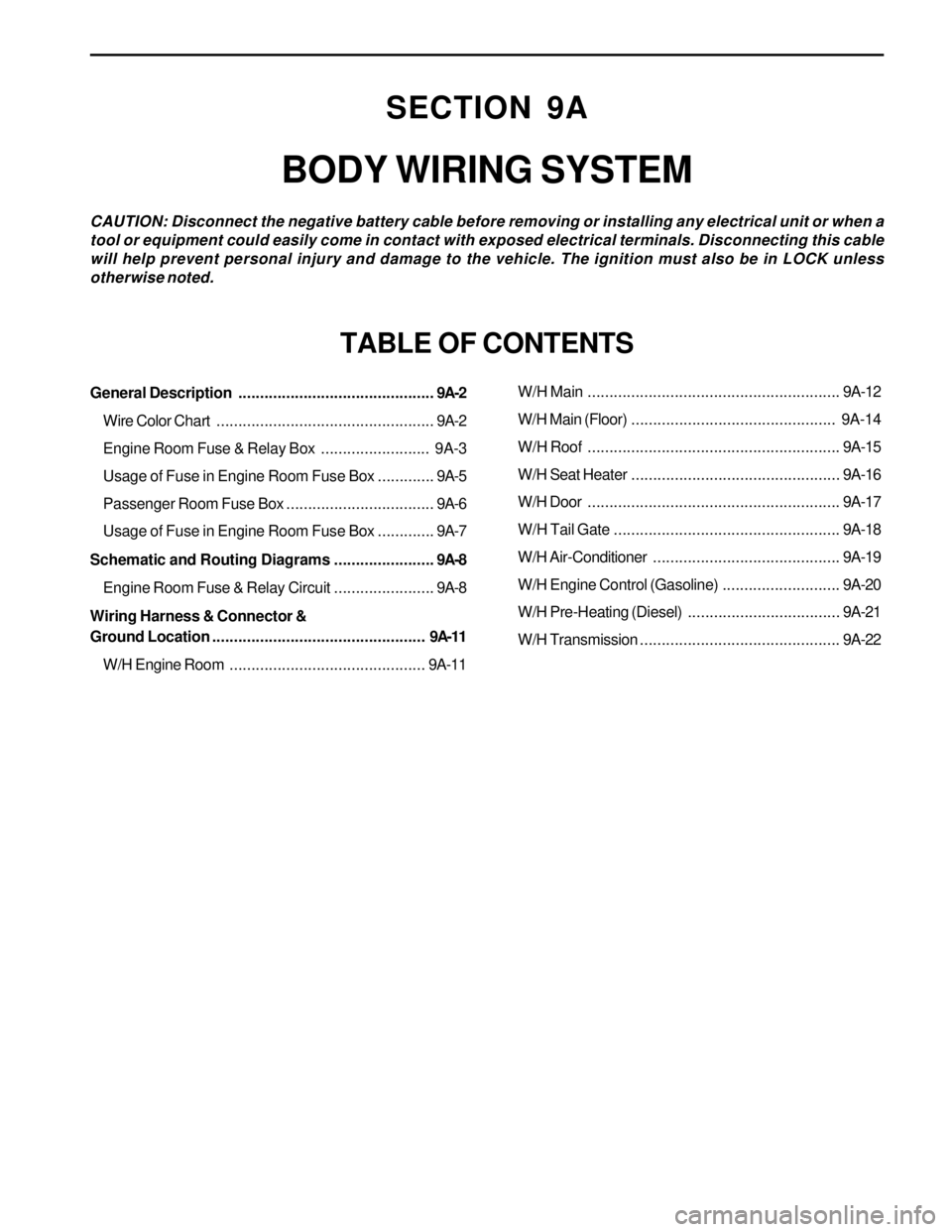
SECTION 9A
BODY WIRING SYSTEM
CAUTION: Disconnect the negative battery cable before removing or installing any electrical unit or when a
tool or equipment could easily come in contact with exposed electrical terminals. Disconnecting this cable
will help prevent personal injury and damage to the vehicle. The ignition must also be in LOCK unless
otherwise noted.
TABLE OF CONTENTS
General Description.............................................9A-2
Wire Color Chart..................................................9A-2
Engine Room Fuse & Relay Box......................... 9A-3
Usage of Fuse in Engine Room Fuse Box.............9A-5
Passenger Room Fuse Box..................................9A-6
Usage of Fuse in Engine Room Fuse Box.............9A-7
Schematic and Routing Diagrams.......................9A-8
Engine Room Fuse & Relay Circuit.......................9A-8
Wiring Harness & Connector &
Ground Location................................................. 9A-11
W/H Engine Room.............................................9A-11W/H Main..........................................................9A-12
W/H Main (Floor)............................................... 9A-14
W/H Roof..........................................................9A-15
W/H Seat Heater................................................9A-16
W/H Door..........................................................9A-17
W/H Tail Gate....................................................9A-18
W/H Air-Conditioner...........................................9A-19
W/H Engine Control (Gasoline)...........................9A-20
W/H Pre-Heating (Diesel)...................................9A-21
W/H Transmission..............................................9A-22